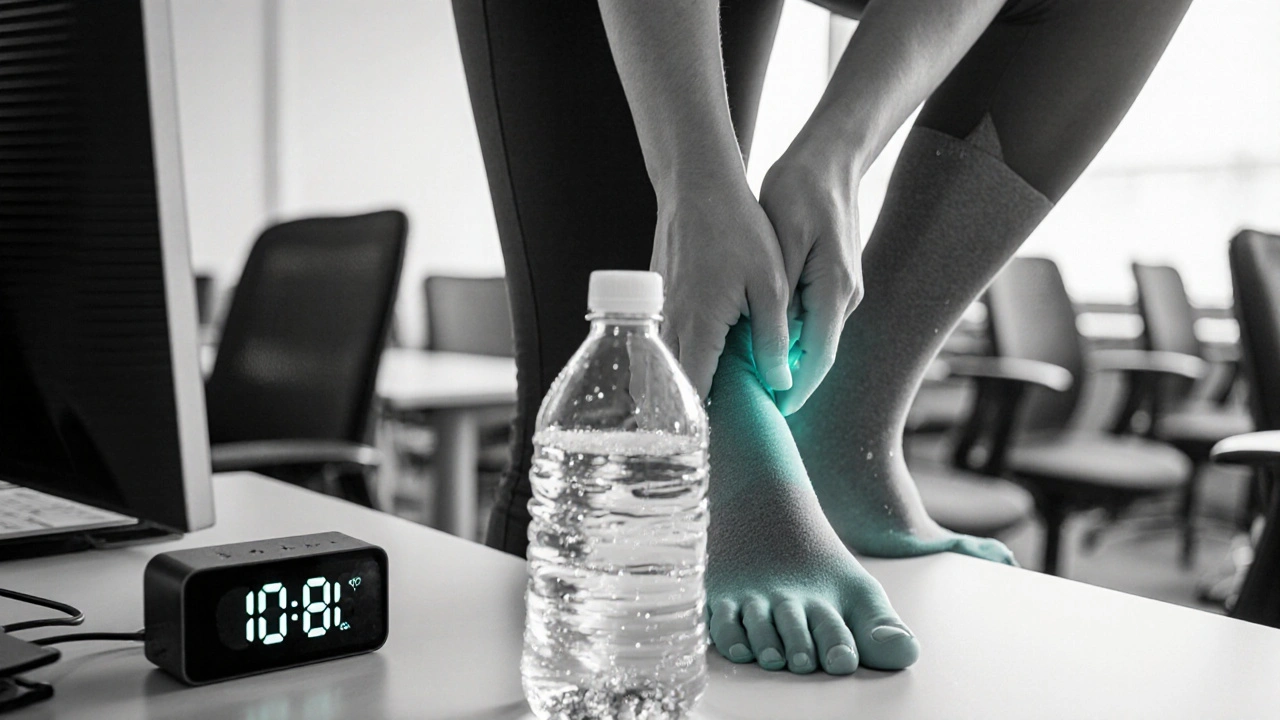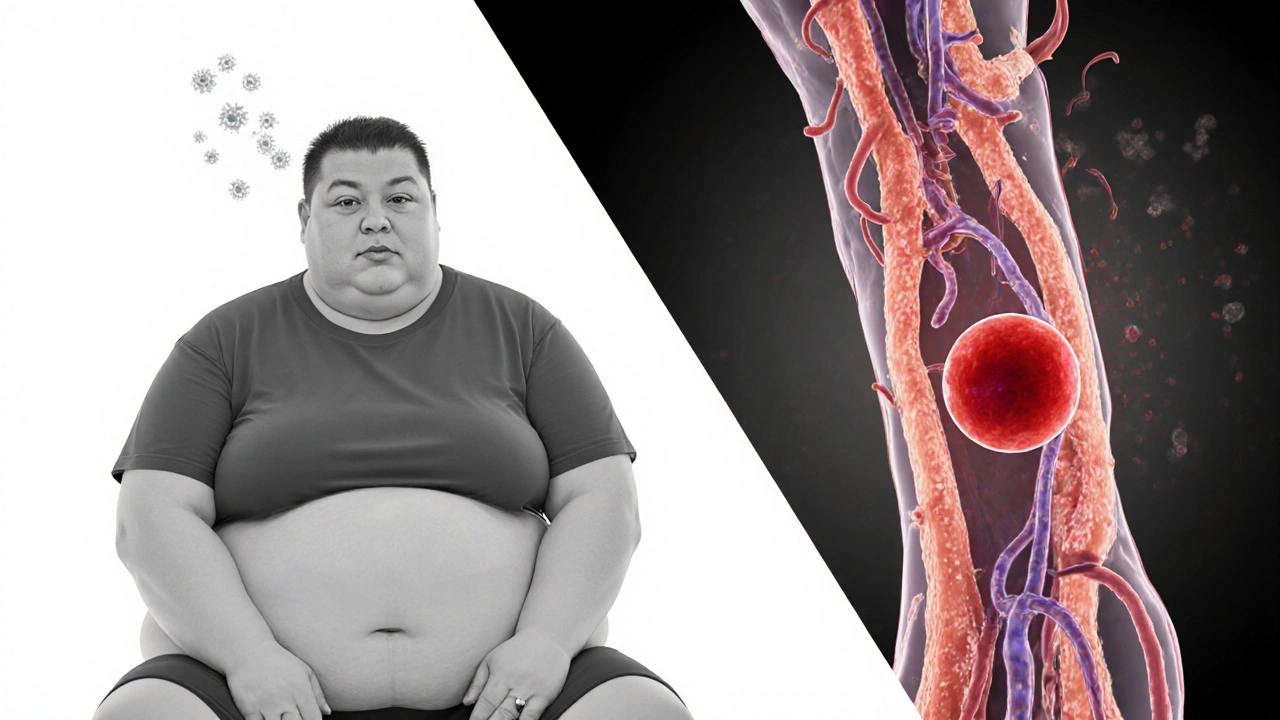BMI and Blood Clot Risk Calculator
Calculate Your Blood Clot Risk
This tool calculates your BMI and shows your relative risk of deep vein thrombosis (DVT) and pulmonary embolism (PE) based on current medical research.
Your BMI
Your Blood Clot Risk
Weight Loss Goal
Personalized Prevention Tips
How Your Risk Compares
| Category | Normal Weight | Overweight | Obesity Class I | Obesity Class II | Obesity Class III |
|---|---|---|---|---|---|
| DVT Risk | 1.0 (baseline) | 1.3 | 1.6 | 1.9 | 2.3 |
| PE Risk | 1.0 (baseline) | 1.2 | 1.5 | 1.8 | 2.1 |
Obesity and blood clots often get mentioned together in health news, but many people still wonder why the extra weight matters and what you can actually do about it. This article breaks down the science, highlights the biggest risks, and gives practical steps you can start using today.
Key Takeaways
- Carrying excess weight raises the chance of deep‑vein thrombosis (DVT) by up to 60% and pulmonary embolism (PE) by about 50%.
- Inflammation, higher blood pressure, and sluggish circulation are the main biological links.
- Even modest weight loss (5‑10% of body weight) can cut clot risk dramatically.
- Staying active, staying hydrated, and using compression gear during long trips are simple, proven preventive measures.
- If you suspect a clot, prompt medical evaluation and possible anticoagulant therapy are vital.
Below you’ll find a step‑by‑step look at how excess weight affects clot formation, how to gauge your own risk, and what lifestyle tweaks can keep your blood flowing smoothly.
How Excess Weight Raises Clot Risk
When you first hear the term obesity is a chronic condition characterized by excess body fat that poses health risks, you might picture a simple cause‑and‑effect: extra weight, more strain on the heart, and that’s it. In reality, several physiological pathways converge to make clotting more likely.
First, the layer of adipose tissue is fat storage that releases hormones and inflammatory molecules into the bloodstream. As fat cells enlarge, they secrete higher levels of cytokines such as interleukin‑6 (IL‑6) and tumor necrosis factor‑α (TNF‑α). These molecules trigger chronic, low‑grade inflammation is a protective response that, when persistent, can damage blood vessels, which in turn makes the inner lining of veins more “sticky.”
Second, obesity often comes with elevated coagulation factor is proteins like fibrinogen and factor VII that help blood clot levels. Studies from 2023 show that people with a body mass index (BMI) over 30 have fibrinogen concentrations 15‑20% higher than those with a normal BMI. Higher fibrinogen means the blood tends to gel faster.
Third, excess weight squeezes abdominal organs and presses on veins, especially in the pelvis and legs. This mechanical pressure slows blood flow, creating the classic “stasis” environment that favors clot formation. Combine stasis with inflamed vessel walls and hyper‑coagulable blood, and you’ve got the perfect storm for a clot.
Clots Most Linked to Obesity
The two most common clot types tied to weight gain are:
- deep vein thrombosis (DVT) is a clot that forms in deep veins, usually in the legs. Obesity raises the odds of DVT by roughly 60% compared with normal‑weight individuals.
- pulmonary embolism (PE) is a life‑threatening condition when a clot travels to the lungs. The risk jumps by about 50% in obese populations.
Obesity also nudges the risk upward for ischemic stroke and heart attack, but those are more influenced by accompanying hypertension and dyslipidemia. For the purpose of this guide, focusing on DVT and PE captures the bulk of weight‑related clot concerns.

Measuring Your Personal Risk
Knowing whether you fall into a higher‑risk bucket starts with a few simple numbers and observations.
- Body Mass Index (BMI): Calculate BMI by dividing weight (kg) by height (m)². A BMI≥30kg/m² defines obesity. While BMI isn’t perfect-it doesn’t distinguish muscle from fat-it’s a quick screening tool.
- Waist Circumference: Measure around the narrowest part of your torso. Men over 40inches and women over 35inches are considered at higher risk for metabolic complications that boost clot likelihood.
- Medical History: Have you had a prior clot, recent surgery, or long‑haul travel? Combine any of those with obesity and the risk compounds.
- Lab Markers: Elevated D‑dimer, fibrinogen, or C‑reactive protein (CRP) can flag a hyper‑coagulable state. Your doctor may order these if you have several risk factors.
If you tick more than one of the above, it’s worth discussing clot‑prevention strategies with a primary‑care or cardiology provider.
Prevention Strategies That Work
Good news: You don’t need a drastic overhaul to lower clot risk. Small, sustainable changes have big payoff.
1. Lose Weight Gradually
Research published in 2024 shows that a 5‑10% reduction in body weight cuts DVT risk by roughly 30%. Aim for a calorie deficit of 500kcal per day, combine with strength‑training to preserve muscle, and track progress with a food‑logging app.
2. Move Frequently
Even short walks break up periods of venous stasis. If you sit for long stretches-office work, gaming, or road trips-set a timer to stand and march for 2‑3minutes every hour. Leg‑raising exercises (or simply flexing calf muscles) are especially helpful during flights.
3. Stay Hydrated
Dehydration thickens blood, making clots more likely. Aim for at least 2liters of water daily, more if you’re active or live in a hot climate.
4. Compression Stockings
Graduated compression (15‑20mmHg) improves venous return from the legs. They’re cheap, easy to wear, and backed by multiple clinical trials for DVT prevention in high‑risk patients.
5. Balanced Diet
Eat plenty of omega‑3‑rich foods (salmon, walnuts, flaxseed) and fiber‑dense veggies. Both lower inflammation and improve endothelial health. Limit processed meats and sugary drinks, which raise triglycerides and clot‑promoting factors.
6. Medications When Indicated
If you have multiple risk factors-obesity, prior clot, recent surgery-a doctor may prescribe a low‑dose anticoagulant is a medication that thins the blood to prevent clot formation such as apixaban or low‑dose aspirin. Medication decisions always weigh bleeding risk against clot risk.
What Happens If You Get a Clot?
Rapid detection saves lives. Typical signs of DVT include swelling, warmth, and pain in one leg-often described as a “heavy” feeling. PE symptoms can be sudden shortness of breath, chest pain that worsens with deep breaths, or a rapid heart rate.
Diagnosis usually starts with a Doppler ultrasound for DVT or a CT pulmonary angiogram for PE. Once confirmed, treatment follows a three‑step pathway:
- Initiate Anticoagulation: Heparin or a direct oral anticoagulant (DOAC) is started immediately to stop clot extension.
- Assess Need for Thrombolysis: Severe PE may require clot‑busting drugs or catheter‑directed therapy.
- Long‑Term Management: After the acute phase, most patients stay on a DOAC for 3‑6months, sometimes longer if obesity or other risk factors persist.
Follow‑up labs (INR for warfarin, renal function for DOACs) and lifestyle counseling are essential to prevent recurrence.

Quick Risk Comparison Table
| BMI Range | Relative Risk of DVT | Relative Risk of PE |
|---|---|---|
| 18.5-24.9 (Normal) | 1.0 (baseline) | 1.0 (baseline) |
| 25.0-29.9 (Overweight) | 1.3 | 1.2 |
| 30.0-34.9 (ClassI Obesity) | 1.6 | 1.5 |
| 35.0-39.9 (ClassII Obesity) | 1.9 | 1.8 |
| ≥40.0 (ClassIII Obesity) | 2.3 | 2.1 |
Bottom Line: Take Action Today
Understanding the link between obesity and blood clots equips you to prevent a potentially fatal event. Start with a realistic weight‑loss goal, keep moving every hour, stay hydrated, and consider compression stockings if you travel often. If you have a personal or family history of clotting, talk to your doctor about a tailored prevention plan.
Frequently Asked Questions
Does being slightly overweight increase clot risk?
Even a BMI in the 25‑29.9 range raises DVT risk by about 30% compared with normal weight. The increase is modest but still meaningful, especially if you have other risk factors like a sedentary job.
Can a healthy diet alone lower clot risk?
A heart‑healthy diet reduces inflammation and improves blood‑vessel function, which indirectly lowers clot risk. However, pairing diet with regular activity and weight management yields the strongest protection.
Are compression stockings necessary for everyone?
They’re most beneficial for people with BMI≥30kg/m², a history of DVT, or those who sit or stand for long periods. If you’re thin and mobile, you can usually skip them.
What are the warning signs of a pulmonary embolism?
Sudden shortness of breath, sharp chest pain that worsens when you breathe deeply, rapid heartbeat, and faintness are classic signs. Seek emergency care immediately if any appear.
Should I take blood‑thinners just because I’m obese?
Routine anticoagulants aren’t recommended for obesity alone. They’re prescribed when multiple risk factors stack, such as previous clot, recent surgery, or a genetic clotting disorder. A doctor can assess your personal risk profile.

 Oct, 15 2025
Oct, 15 2025

Jessica Di Giannantonio
October 15, 2025 AT 20:08Wow, reading this feels like turning on a bright light in a dim room – the connection between extra pounds and clot risk is finally crystal clear. I’m amazed how even a modest weight drop can shrink that dangerous 60% DVT odds. Let’s all keep moving, stay hydrated, and remember we’ve got the power to protect our veins.
RUCHIKA SHAH
October 21, 2025 AT 08:08It is true that small changes help and the body thanks us for staying active.
Justin Channell
October 26, 2025 AT 19:08Totally agree keep walking and drink water 💧 it really cuts the risk 👍
Basu Dev
November 1, 2025 AT 07:08When we examine the physiologic cascade that links adiposity to hypercoagulability, the first point of entry is the chronic inflammatory state generated by enlarged adipocytes, which secrete a profusion of cytokines such as interleukin‑6 and tumor necrosis factor‑α; these molecules not only perpetuate systemic inflammation but also directly alter endothelial function, rendering the vascular lining more adhesive to circulating platelets. Simultaneously, excess body mass exerts mechanical pressure on the venous system of the pelvis and lower extremities, a phenomenon that slows venous return and creates zones of stasis, the classic environment for clot formation as described by Virchow's triad. Moreover, the metabolic derangements observed in obesity, including insulin resistance and dyslipidemia, further amplify pro‑thrombotic pathways by increasing the synthesis of fibrinogen and factor VII, thereby shortening clotting times in standard coagulation assays. In clinical studies spanning the last decade, individuals with a body mass index above thirty have demonstrated fibrinogen levels that are consistently 15 to 20 percent higher than their lean counterparts, a difference that translates into a measurable increase in thrombin generation. Additionally, the presence of elevated C‑reactive protein, a surrogate marker of inflammation, correlates strongly with the incidence of deep‑vein thrombosis in postoperative patients, reinforcing the link between inflammation and clot risk. Another layer of complexity is added by the altered shear stress patterns within veins that occur as abdominal fat presses on the inferior vena cava and iliac veins, disrupting laminar flow and fostering turbulent currents that activate endothelial cells. From a therapeutic standpoint, the implementation of graduated compression stockings has been shown in randomized trials to improve venous return by up to 30 percent, thereby mitigating stasis in high‑risk populations. Equally important is the role of regular ambulation; even brief periods of standing and calf muscle contraction every hour can double the velocity of blood through the femoral vein. Hydration, often overlooked, plays a crucial role as well; dehydration raises plasma viscosity, which directly enhances the probability of fibrin polymerization. Finally, modest weight loss, defined as a 5‑10 percent reduction in body weight, has been associated with a corresponding 30 percent drop in deep‑vein thrombosis incidence, highlighting the tangible benefits of lifestyle modification. Taken together, these mechanisms illustrate a multifactorial interplay between adipose tissue, inflammation, hemodynamics, and coagulation factors that collectively elevate clot risk in obesity. Understanding this intricate network empowers clinicians and patients alike to adopt targeted preventive measures that address each component of the risk equation, from dietary adjustments to mechanical interventions. In summary, the synergy of inflammatory cytokines, hyper‑coagulable blood profiles, and venous stasis creates a perfect storm for thrombosis, but one that can be dismantled through comprehensive, evidence‑based strategies. Patients should also discuss with their physicians the potential benefit of low‑dose anticoagulants when multiple risk factors coexist, as personalized prophylaxis can further reduce event rates. By integrating lifestyle changes with appropriate medical oversight, the elevated clot risk associated with obesity can be substantially mitigated.
Krysta Howard
November 6, 2025 AT 19:08Stop ignoring the science and just start wearing those compression socks.
nica torres
November 12, 2025 AT 07:08Hey, you’re right! Grab a pair today and feel the difference – your legs will thank you.
Dean Marrinan
November 17, 2025 AT 19:08Oh sure, because the only thing standing between us and a deadly clot is a neon‑bright pair of socks that scream “I’m ready for a flight” 😂✈️
Oluseyi Anani
November 23, 2025 AT 07:08Actually, the data shows that proper compression therapy reduces DVT rates by up to 40 percent, so it’s less about neon fashion and more about proven medicine.
Rahul yadav
November 28, 2025 AT 19:08Wow, you’ve just turned a simple tip into a heroic battle against invisible enemies – thank you for the epic reminder! 🙌💪
Ryan Pitt
December 4, 2025 AT 07:08Great summary – stay active, stay hydrated, stay safe.
Jami Johnson
December 9, 2025 AT 19:08Indeed, the combination of regular movement, adequate fluid intake, and mindful weight management forms a triad of protection that can dramatically lower the odds of clot formation, turning a potentially fatal scenario into a manageable health journey.